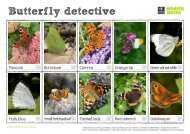CHOBHAM COMMON NNR - Surrey Wildlife Trust
CHOBHAM COMMON NNR - Surrey Wildlife Trust
CHOBHAM COMMON NNR - Surrey Wildlife Trust
You also want an ePaper? Increase the reach of your titles
YUMPU automatically turns print PDFs into web optimized ePapers that Google loves.
poor structural diversity of the sward and increased abundance of purple moor grass.<br />
Historically, active management played a significant part in shaping and developing<br />
the habitat in a way considered to be highly beneficial to the heathland ecosystem.<br />
However, a range of management practices will be required to establish favourable<br />
condition of the heathland. These might include grazing, flail cutting, controlled burns,<br />
scrub removal, gorse coppicing and bare ground creation or combinations of these.<br />
The full range of possible management practices must be considered in a public<br />
engagement and dialogue process which will address both continued public access<br />
to, and enjoyment of, the area, whilst also achieving favourable condition for the site<br />
Fragmentation – The site is fragmented by the M3 motorway and other roads that<br />
cross it and by roadside strips of gorse and other vegetation.<br />
Uncertainty over management agreements – Uncertainty over the continuation<br />
and nature of management agreements for Broomhall Heath, West Wood, Valley<br />
Wood, Gracious Pond and the land east of Burma Road is a cause for concern.<br />
Vulnerable species – The location of Formica rufibarbis and sand lizard on single<br />
locations makes them vulnerable to fire, disturbance and habitat change.<br />
Inappropriate uses –Uncontrolled dogs are a threat to ground nesting birds, a<br />
nuisance to visitors and a potential health risk. Regular problems with litter, fly tipping<br />
and vandalism, and less frequent incursions by travellers, and motorcyclists and<br />
arson attacks are a serious drain on limited available resources. Horse riding and<br />
cycling off appropriate routes can cause erosion, disturbance and safety risks. Over<br />
collection of fungi in the autumn months is also a cause for concern.<br />
2.1.3. External opportunities<br />
Neighbouring land – To link the management of the remaining areas of the<br />
Chobham Common SSSI (west of Chobham Road, and Round Pond Woods) and of<br />
newly restored heathland areas at Stanner’s Hill with that of the <strong>NNR</strong>.<br />
SANGs – The provision of appropriate Suitable Accessible Natural Greenspaces as<br />
mitigation for developments in the area to act as alternative sites for dog walking and<br />
off-road cycling.<br />
Sustainable use of materials – The sustainable disposal of timber, turves, heather<br />
and other materials for income, in exchange for works or as an alternative to more<br />
labour or cost intensive forms of disposal.<br />
Filming – Income from filming where it does not impact on the nature conservation<br />
or visitor use of the site.<br />
Pedestrian access - To improve pedestrian access from Sunningdale and<br />
Windlesham.<br />
Re-introductions – To investigate re-introducing or introducing smooth snake,<br />
natterjack toad (Bufo calamita), and white-faced darter (Leucorrhinia dubia).<br />
2.1.4. External challenges<br />
Nitrogen and sulphur deposition – High levels of nitrogen and sulphur deposition<br />
are a threat to the low nutrient N-limited habitats on the sites and nutrient build up will<br />
favour competitor species such as Molinia caerulea and Pteridium aquilinum.<br />
24



![Thursley Common [Shrike Hill] (SU9041) & Sheets Heath (SU9457 ...](https://img.yumpu.com/11846073/1/184x260/thursley-common-shrike-hill-su9041-sheets-heath-su9457-.jpg?quality=85)

